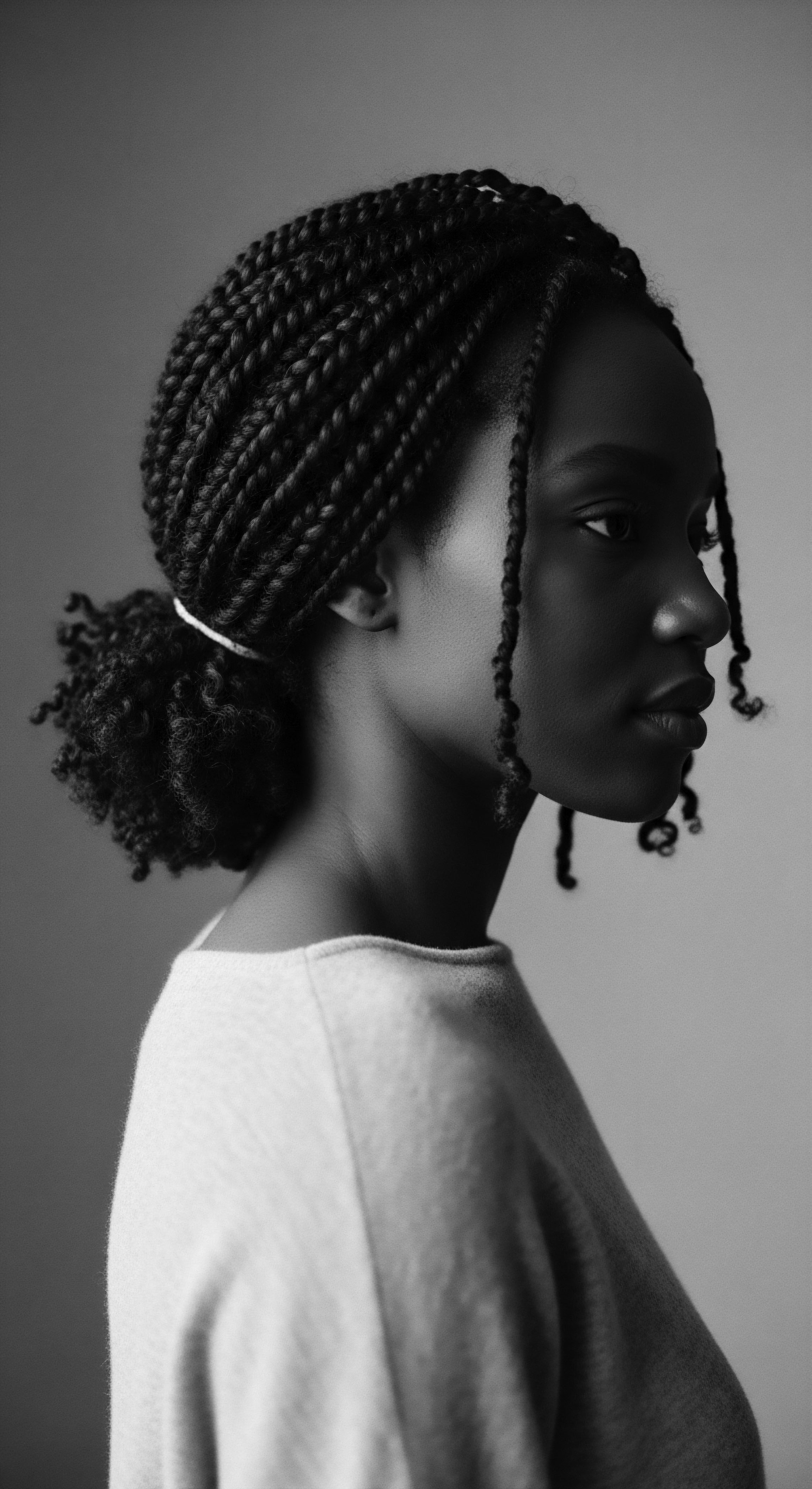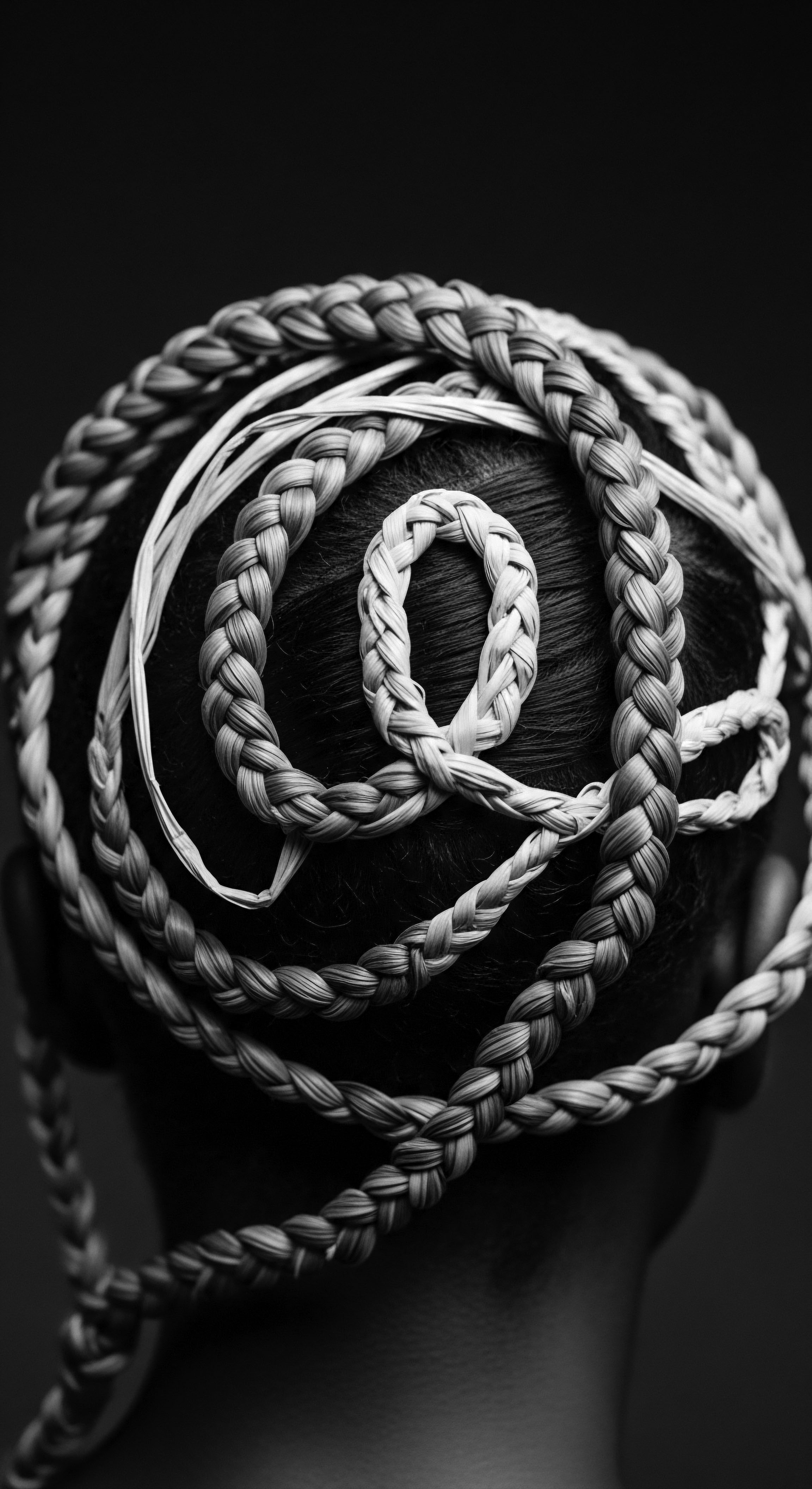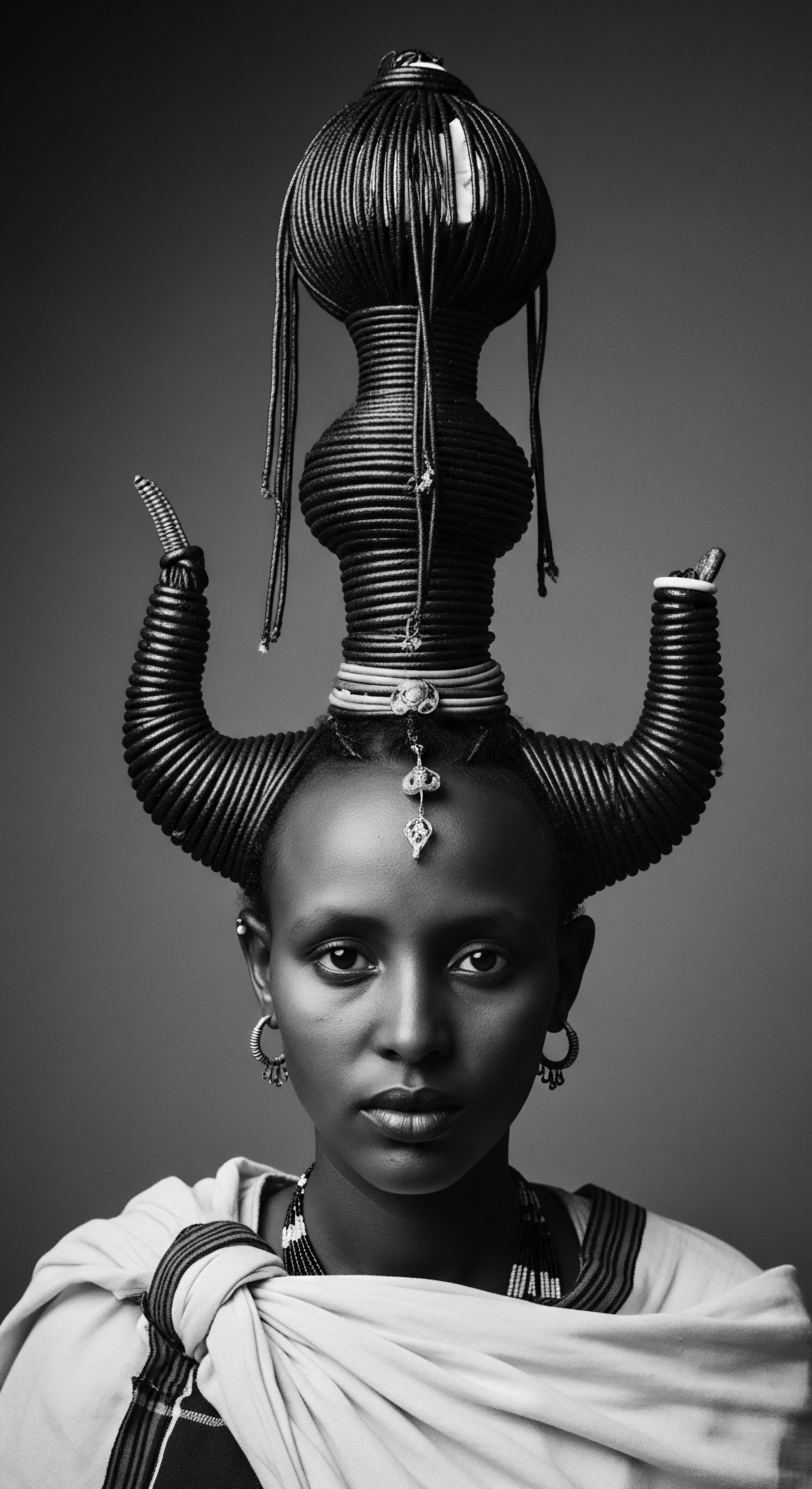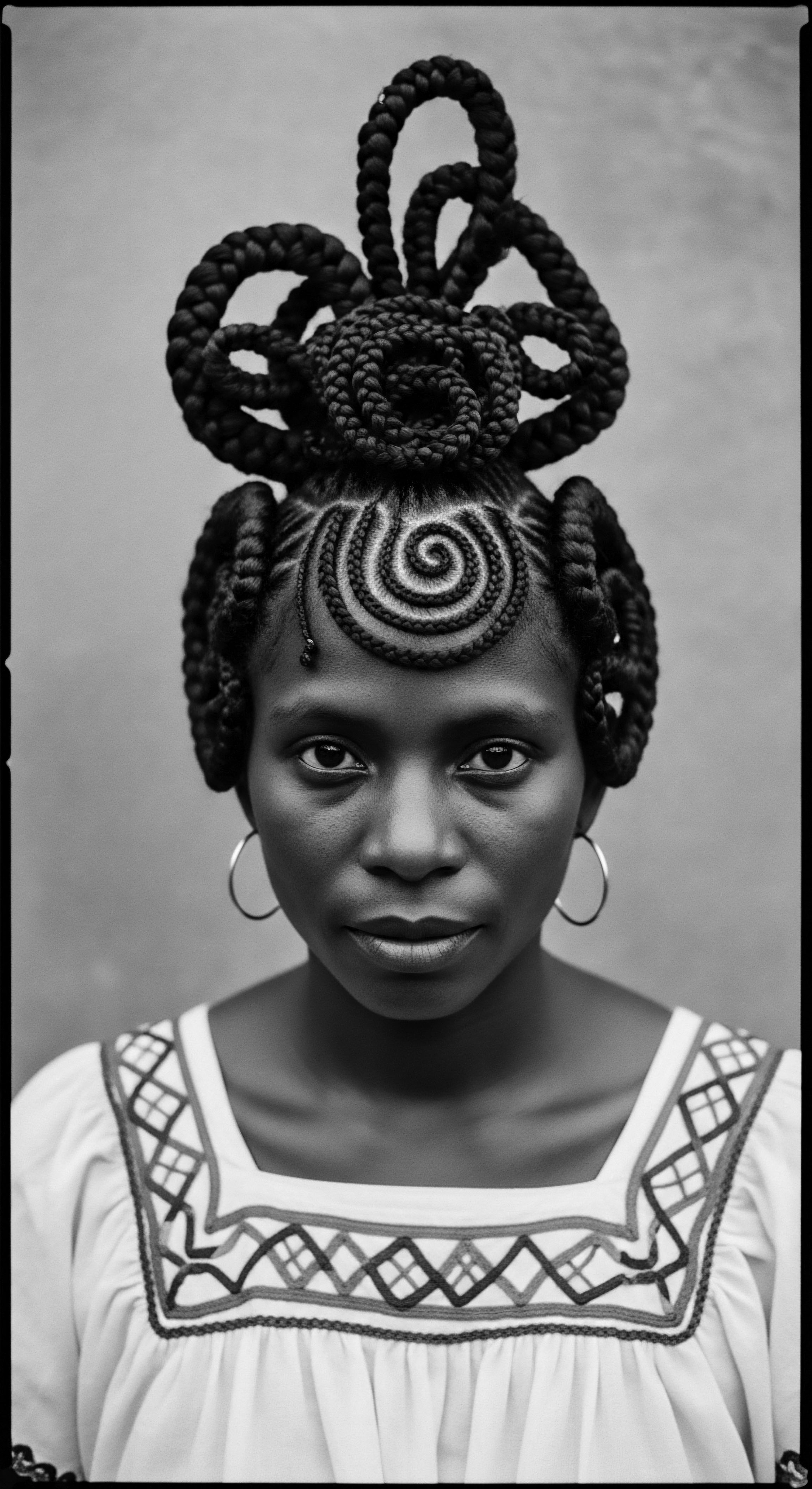
Fundamentals
The concept of Plantain Skins, at its core, refers to the outer layers of the plantain fruit, botanically classified within the genus Musa. While often considered a mere byproduct of consumption, these coverings possess a heritage of utility far beyond the kitchen. For many communities, particularly those with deep historical ties to tropical and subtropical climates, the plantain skin embodies a resourcefulness, an intrinsic value stemming from generations of ingenious application. Its fundamental meaning extends beyond a simple botanical description; it holds a profound cultural significance.
Across various ancestral practices, Plantain Skins served as a readily available, nutrient-rich material, a testament to the wisdom embedded within communities that understood the full potential of their natural surroundings. This understanding provided the basis for a range of uses, from remedies to beauty rituals, particularly in the realm of hair care. The plantain, often starchier and less sweet than its banana cousin, holds a distinct place in global diets and traditional medicine.
Plantain Skins represent an often-overlooked bounty, holding an ancient connection to ancestral wisdom and hair vitality across diverse cultural landscapes.

Elemental Composition and Ancestral Recognition
Observing the Plantain Skins through the lens of early, discerning eyes would have revealed their potential, even without modern scientific instruments. These skins contain a spectrum of compounds, including vitamins A, C, and E, alongside minerals such as potassium and magnesium. These are nutrients recognized today for their role in fostering healthy skin and hair.
Beyond this, the skins also contain antioxidants and anti-inflammatory properties, qualities that would have been intuitively appreciated by ancestral practitioners seeking soothing and restorative effects. The presence of mucilage, a gummy substance, grants a natural slipperiness, a characteristic likely prized for its conditioning and detangling benefits for textured hair.
The early recognition of these properties was not an abstract pursuit; it was born of daily observation and necessity. Communities in regions where plantains thrived, such as West Africa and later the Caribbean and Latin America, integrated every part of this plant into their holistic well-being. The Plantain Skins thus earned their designation not through formal scientific study but through centuries of experiential knowledge passed down through oral traditions and communal practice.

Cultural Significance Beyond Sustenance
The plantain’s journey through history illustrates its centrality to human existence, not just as a food source but as a cultural cornerstone. Originating in Southeast Asia and the South Pacific, the plantain traveled through ancient trade routes to Africa, eventually arriving in the Americas. Its widespread presence meant that its skins, rather than being discarded, became a symbol of ingenuity and circular economy within traditional societies.
- Resourcefulness ❉ Ancestral communities used all parts of the plantain, reflecting a deep respect for natural resources and a practical approach to daily needs.
- Accessibility ❉ The plantain’s widespread growth in tropical climates made its skins a readily available and affordable ingredient for hair care, a stark contrast to many modern, expensive hair products.
- Sustainability ❉ Repurposing the skins minimized waste, embodying an ancient principle of ecological awareness and living in concert with the land.
This resourcefulness provided sustenance for both body and spirit, with the skins quietly contributing to the maintenance of beauty and health rituals.

Intermediate
Moving beyond the basic designation, the Plantain Skins represent a powerful element in the ancestral lexicon of natural care, particularly within the context of textured hair. Their significance arises not only from their physical attributes but also from the way they were integrated into hair traditions, embodying a deep understanding of natural resources and their application for resilience and beauty. The interpretation of Plantain Skins in this sphere speaks to a heritage of self-sufficiency and the profound connection between cultural identity and hair care.

Traditional Preparations and Applications
The preparation of Plantain Skins for hair care varied by region and specific community, yet common methods emerged, highlighting a shared experiential knowledge. These preparations often involved simple, accessible processes that allowed communities to harness the inherent properties of the skins.
One prominent application involved the creation of concoctions designed to condition and soothe the scalp. Boiling the skins, for instance, extracts their mucilage, a gelatinous substance known for its softening and detangling effects on hair. This liquid, once cooled, would serve as a rinse, providing slip for easier manipulation of coils and curls, a constant concern for textured hair types. The presence of vitamins and minerals within the skins would then nourish the scalp, supporting overall hair health.
Another significant traditional use saw Plantain Skins as a core ingredient in the crafting of natural soaps. African Black Soap, renowned for its cleansing and purifying attributes, often incorporates the ash derived from dried plantain peels alongside other botanicals like cocoa pods and palm oil. This soap offered a gentle yet effective means of removing impurities without stripping the hair of its natural oils, a balance critical for maintaining the health of textured strands. This practice illustrates a sophisticated ancestral understanding of saponification and the delicate chemistry of cleansing.
The historical significance of Plantain Skins for textured hair care lies in their ability to provide natural conditioning, soothing relief, and effective cleansing through resourceful, time-honored preparations.

A Legacy of Resourcefulness ❉ The Caribbean Experience
The journey of the plantain to the Caribbean islands, brought by Spanish and African traders, is a historical narrative interwoven with forced migration and cultural adaptation. Though not indigenous to the Americas, plantains became a staple, their abundance providing crucial sustenance and, importantly, a resource for maintaining traditional wellness and beauty practices. The resourcefulness inherent in Black hair practices finds a poignant echo in the historical adoption of readily available botanicals like the plantain. In the Caribbean, where the cruelties of the transatlantic slave trade severed many direct ties to West African flora, enslaved communities and their descendants ingeniously adapted, incorporating local and introduced plants into their wellness and beauty regimens.
This resourceful spirit represented a profound continuity of care, a quiet act of preserving heritage. Ethnomedical studies documenting the therapeutic applications of common plants among Afro-descendant populations throughout the Caribbean islands often detail the plantain as a foundational component for various ailments and general well-being (Laguerre, 1987). This historical reliance on plantain underscores its dual value as both a food source and a medicinal or cosmetic agent, affirming its role in maintaining cultural identity amidst displacement.
| Traditional Application Hair Rinse (boiled skins/leaves) |
| Associated Benefit for Hair/Scalp Softening, detangling, soothing irritated scalp, providing shine. |
| Cultural Context Common across various tropical regions for easy manipulation of textured hair. |
| Traditional Application African Black Soap Component (ash from skins) |
| Associated Benefit for Hair/Scalp Gentle cleansing, balancing scalp pH, addressing flakiness. |
| Cultural Context Integral to West African and diasporic cleansing rituals, known for its mild nature. |
| Traditional Application Poultices/Masks (mashed skins/pulp) |
| Associated Benefit for Hair/Scalp Deep conditioning, scalp nourishment, anti-inflammatory effects. |
| Cultural Context Used for intense treatments, reflecting a holistic approach to hair wellness. |
| Traditional Application These applications highlight ancestral ingenuity in adapting readily available botanicals for holistic care within diverse communities. |
The knowledge of how to prepare and utilize these plant-based remedies was transmitted orally, from elder to youth, often during communal gatherings where stories and wisdom were exchanged. This perpetuation of knowledge was not simply about recipes; it was about the collective memory of resilience, the dignity found in self-care, and the deep understanding of their ancestral roots despite the severing of geographical ties.

Bridging Generations with Plantain Wisdom
The enduring value of Plantain Skins for textured hair care persists into the modern day, often manifesting in contemporary formulations that draw inspiration from these traditional practices. The lessons gleaned from ancestral wisdom continue to shape our approach to natural hair care, reminding us that efficacy often resides in simplicity and the gifts of the earth. The Plantain Skins offer a profound bridge between the rich heritage of care and current desires for authentic, wholesome beauty solutions.

Academic
The rigorous academic examination of Plantain Skins for textured hair care transcends anecdotal accounts, delving into their complex phytochemistry and elucidating their mechanisms of action, all while remaining grounded in their historical and cultural significance. A comprehensive understanding of the Plantain Skins necessitates an interdisciplinary approach, drawing from ethnobotany, nutritional science, and dermatological principles to fully grasp their meaning. This scholarly interpretation reveals not just their historical utility, but a scientific basis that often affirms ancestral wisdom concerning hair and scalp vitality. The Plantain Skins thus emerge as a compelling subject for study, offering insights into traditional ecological knowledge and its contemporary relevance.

Phytochemical Profile and Hair Health Mechanisms
The chemical composition of Plantain Skins accounts for their purported benefits in hair care. These peels are a repository of bioactive compounds that exert a range of beneficial effects on the scalp and hair fiber. Key among these are the vitamins and minerals that contribute to cellular health.
- Vitamins A, C, and E ❉ Vitamin A supports cell growth, vital for scalp health and hair follicle function. Vitamin C acts as an antioxidant, shielding hair follicles from environmental damage and supporting collagen production, which is a structural component of hair. Vitamin E, a potent moisturizer, contributes to hair hydration and softness.
- Potassium and Magnesium ❉ Potassium plays a role in cell regeneration and nutrient transport, which can support hair growth. Magnesium is involved in protein synthesis and blood circulation, both crucial for healthy hair development.
- Antioxidants and Anti-Inflammatory Agents ❉ Flavonoids and phenolic compounds present in Plantain Skins offer significant antioxidant activity, mitigating oxidative stress on the scalp, which can contribute to hair thinning and premature aging. Their anti-inflammatory properties soothe irritated scalps, addressing common concerns like dandruff, eczema, and psoriasis, which are prevalent in many textured hair communities.
Beyond these, the mucilage content in Plantain Skins deserves particular attention for textured hair. This polysaccharide material forms a protective, slippery gel when hydrated. When applied to hair, this mucilage provides a natural ‘slip,’ facilitating easier detangling of tightly coiled or curly strands, thereby reducing breakage.
This mechanical benefit is of immense practical value in the daily care of textured hair, minimizing manipulation and preserving length. This property aligns perfectly with ancestral detangling methods that relied on slippery plant-based ingredients.

Ethnobotanical Pathways and Diasporic Adaptations
The global journey of the plantain, originating in Southeast Asia and traversing continents to establish itself as a cornerstone in African, Caribbean, and Latin American diets, mirrors a deeper story of human migration and cultural adaptation. Archaeological evidence suggests plantains arrived in West Africa as early as 3000 years before the present. This deep history underscores the plantain’s enduring presence in regions where textured hair traditions are strongest.
In the context of the transatlantic slave trade, the plantain became a vital survival crop in the Americas. Enslaved Africans, forcibly displaced from their homelands, carried with them an invaluable botanical intelligence, a nuanced understanding of plant uses. Deprived of the familiar flora of their ancestral lands, they ingeniously adapted, identifying similar or equivalent properties in new environments. The readily available plantain, already a dietary staple, thus became a natural extension of traditional beauty and wellness practices.
This adaptation was not merely pragmatic; it was an act of profound cultural preservation, a way of maintaining continuity and dignity in the face of immense adversity. The Plantain Skins became a silent participant in these acts of resistance and resilience, their application to hair a continuation of ancestral care rituals.
Consider the widespread use of African Black Soap, a cleanser whose traditional formulation often incorporates the ash of dried plantain skins. This soap, with its gentle cleansing and purifying properties, is a direct link to ancestral practices and remains highly valued in communities with textured hair heritage. Its presence signifies a continuous thread of wisdom, where natural resources are transformed into beneficial solutions for hair and scalp health. The continued preference for such formulations today, often rooted in specific regional variations, speaks to the efficacy and cultural resonance of these practices across generations.
The academic exploration of Plantain Skins reveals a sophisticated interplay of phytochemistry and cultural adaptation, where ancestral knowledge of natural resources provided effective solutions for textured hair care, embodying resilience and ingenuity.

Contemporary Reaffirmations and Future Directions
Modern scientific inquiry often serves to validate the empirical observations passed down through oral tradition. The laboratory analysis of Plantain Skins confirms the presence of compounds long utilized by ancestral communities for their health-giving properties. This convergence of ancient wisdom and contemporary science lends further authority to the significance of Plantain Skins in hair care.
For instance, the efficacy of Plantain Skins in soothing irritated scalps due to their anti-inflammatory compounds aligns with their historical application for various skin conditions. The nourishing vitamins and minerals support hair growth and strength, corroborating traditional beliefs in their ability to promote healthy hair.
Future research may further dissect the specific molecular interactions responsible for the observed benefits of Plantain Skins on textured hair. This could lead to innovative, heritage-inspired formulations that honor ancestral practices while leveraging modern scientific advancements. The ongoing interest in natural, plant-based ingredients within the beauty industry also points to a renewed appreciation for resources like Plantain Skins, signaling a return to foundational principles of care that prioritize authenticity and holistic well-being.
The Plantain Skins, therefore, stand as a testament to the enduring power of ancestral knowledge, a living archive of care that continues to shape our understanding of hair health and identity. Their story is a powerful illustration of how deep understanding of natural elements, coupled with resourceful application, can transcend centuries, offering profound lessons for our present and guiding our path towards a more harmonized future of care.
- Topical Application Method ❉ Prepare a decoction by boiling Ripe Plantain Skins in water. Allow the liquid to cool, then strain and use as a final hair rinse after cleansing. This method provides natural conditioning and detangling benefits, particularly for coil patterns.
- Mask Preparation ❉ Mash Softened Plantain Skins into a pulp, combining with other natural ingredients such as avocado or a nourishing oil. Apply this mixture as a deep conditioning mask to freshly washed hair, allowing it to sit before rinsing thoroughly.
- Traditional Cleansing Formulation ❉ Incorporate Plantain Skin Ash into homemade African Black Soap. This process utilizes the inherent saponifying agents in the ash to create a gentle, purifying cleanser beneficial for the scalp and hair.

Reflection on the Heritage of Plantain Skins
To consider the Plantain Skins is to pause and reflect upon a profound, often understated, chapter in the enduring story of textured hair. It is to acknowledge the ancestral hands that, through necessity and wisdom, perceived value where others saw only discard. These humble peels, discarded by many today, carry the resonance of generations, a quiet strength that speaks volumes about ingenuity, adaptation, and an unbroken lineage of self-care. The journey of the plantain, from distant shores to the hearths of the diaspora, embodies a larger narrative of resilience—the capacity of communities to adapt, to innovate, and to sustain their traditions, even as circumstances shifted dramatically.
The knowledge held within the Plantain Skins, translated into conditioners and cleansers, was not just about superficial appearance. It spoke to a deeper connection to the land, to the cycles of nature, and to the inherent ability of the natural world to provide for our well-being. This was a holistic approach, where the nourishment of the body intertwined with the care of the self, and where beauty rituals served as conduits for cultural continuity. Each application, each shared recipe, fortified a sense of belonging and affirmed a distinct identity shaped by historical realities yet rooted in profound heritage.
Today, as many seek to reconnect with natural solutions and sustainable practices, the Plantain Skins offer a timeless lesson. They remind us that true value often resides in the readily available, in the unadorned wisdom of the past. Their continued presence in modern hair care, whether explicitly recognized or subtly incorporated, ensures that the tender thread of ancestral knowledge remains visible, guiding us toward practices that honor our hair’s unique story and its deep, soulful connection to the earth. It is a quiet call to remember, to honor, and to carry forward this living archive of care, ensuring its echoes continue to enrich future generations.

References
- Blench, R. (2009). Bananas and Plantains in Africa ❉ Re-interpreting the linguistic evidence. Ethnobotany Research and Applications.
- De Langhe, E. (2007). The establishment of traditional plantain cultivation in the African rainforest. ResearchGate.
- Laguerre, M. S. (1987). Afro-Caribbean Folk Medicine. Bergin & Garvey Publishers.
- Mbida, C. M. Van Neer, W. Doutrelepont, H. & Vrydaghs, L. (2000). Evidence for Banana Cultivation and Animal Husbandry During the First Millennium BC in the Forest of Southern Cameroon. Journal of Archaeological Science, 27(2), 179-183.
- Pushpangadan, P. Kaur, J. & Sharma, J. (1989). Plantain or edible banana (Musa x paradisica var. sapiemtum) some lesser known folk uses in India. Ancient Science of Life.
- Rossel, G. (1998). Ethnobotany of the Bananas (Musa Species) of Africa ❉ A Linguistic and Cultural Approach. ResearchGate.
- Simmonds, N. W. (1962). The Evolution of the Bananas. Longman.
